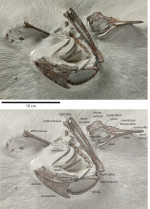Systematic Palaeontology
Order Procellariiformes Fürbringer, 1888
The present fossils belong to Procellariiformes because of their straight, deeply grooved beaks, prominent dorsally opening nostrils, enlarged nasal glands above the eyes, and long, narrow wing bones.
Family Procellariidae Leach, 1820
The present fossils belong to Procellariidae because of their intermediate size (Diomedeidae are larger, Oceanitidae and Hydrobatidae smaller), gracile beaks, and dorsally projecting nostrils.
Genus
Ardenna Reichenbach, 1853
Type species:
Procellaria gravis O’Reilly, 1818.
Ardenna buchananbrowni sp. nov. (Figure 1)
ZooBank reg.: urn:lsid:zoobank.org:act:A24C44F5-1969-4A6E-85F7-24B468BC5BCF
Holotype: NMNZS.49931, partial articulated skeleton collected by Karl Raubenheimer, preserving the complete skull and premaxilla, posterior right mandible, sternum, furcula, right coracoid, a row of articulated thoracic vertebrae, four ribs, both humeri, right ulna, right radius, and several small unidentified fragments (Figure 1).
Type locality and horizon: Ohawe Beach, southern Taranaki, New Zealand (39◦35.55′ S 174◦12.45′ E). Tangahoe Formation. (Fossil Record ElectronicDatabase FRNumberQ21/F0175). Age: Late Pliocene, Piacenzian/Waipipian; 3.36–3.06 Ma.
Paratype: NMNZ S.49666, partial skeleton preserving the complete skull and premaxilla, left quadrate, right coracoid, both humeri (missing their distal ends), right ulna, probable right radius, one vertebra, and several small unidentified fragments (Figure 2). This skeleton is similar in size to the holotype and was collected by John Buchanan-Brown at Waihi Beach, South Taranaki, New Zealand (39◦36.13′ S 174◦14.08′ E). Formation and age as for the holotype.
Etymology: The specific epithet honours John Buchanan-Brown, the discoverer of the paratype.
Diagnosis: Small species of shearwater differing from all procellariids except
Ardenna,
Calonectris, and
Puffinus in having a thin elongate beak and long olecranon process of the ulna. Further differs from
Calonectris and all species of
Ardenna except
A. grisea and
A. tenuirostris in having a shallow brachial fossa on the humerus, a dorsoventrally flattened humeral shaft, and a humerus/ulna length ratio ≥ 1.05 (Tables 1 and 2). Differs from
Ardenna in being smaller overall but is comparable
Our PCA clusters the new fossils with A
rdenna but still within the 95% confidence ellipse of
Puffinus, reflecting their intermediate size and morphology (Figure 3A; Supplementary File S1). PC1 accounts for 78% of the variation and largely reflects size. By contrast,
PC2 accounts for 12% of the variation and broadly separates diving shearwaters (
Puffinus,
Ardenna grisea, and
A. tenuirostris) from gliding forms (other
Ardenna), with the new species clustering with the divers. Overall, it falls closest to
A. tenuirostris, but differs from the latter, like from all
Ardenna, in having a shorter humerus and ulna (Table 2). For a comparison of size and morphology between diving shearwaters (
Puffinus,
A. grisea, and
A. tenuirostris) and gliding
Ardenna, see Supplementary File S2.
Figure 1. Pliocene fossil shearwater Ardenna buchananbrowni sp. nov. Photograph of holotype
NMNZ S.49931 (top) and explanatory line drawing (bottom).
Fred
Figure 1. Pliocene fossil shearwater
Ardenna buchananbrowni sp. nov. Photograph of holotype NMNZ S.49931 (top) and explanatory line drawing (bottom).






